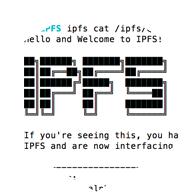IPFS powers the Distributed Web
A peer-to-peer hypermedia protocol
designed to preserve and grow humanity's knowledge
by making the web upgradeable, resilient, and more open.
The web of tomorrow needs IPFS today
IPFS aims to complement HTTP in order to build a better web for all of us.
Today's web is inefficient and expensive
HTTP downloads files from one server at a time — but peer-to-peer IPFS retrieves pieces from multiple nodes at once, enabling substantial bandwidth savings. IPFS makes it possible to efficiently distribute high volumes of data without duplication.
Today's web can't preserve humanity's history
The average lifespan of a web page is 100 days before it's gone forever. The medium of our era shouldn't be this fragile. IPFS makes it simple to set up resilient networks for mirroring data, and thanks to content addressing, files stored using IPFS are automatically versioned.
Today's web is centralized, limiting opportunity
The Internet has turbocharged innovation by being one of the great equalizers in human history — but increasing consolidation of control threatens that progress. IPFS stays true to the original vision of an open, flat web by delivering technology to make that vision a reality.
Today's web is addicted to the backbone
IPFS powers the creation of diversely resilient networks that enable persistent availability — with or without internet backbone connectivity. This means better connectivity for the developing world, during natural disasters, or just when you're on flaky coffee shop wi-fi.
Install IPFS
Join the future of the web right now — just choose the option that's right for you.
Store and provide files

IPFS Desktop
IPFS for everyone
The IPFS Desktop app offers menubar/tray shortcuts and an easy interface for adding, pinning, and sharing files — plus a full IPFS node ready for heavy-duty hosting and development. Great for developers and less experienced users alike.

Command-line install
All IPFS, no frills
Just want to use IPFS from your terminal? Follow these step-by-step instructions for getting up and running on the command line using the Go implementation of IPFS. Includes directions for Windows, macOS, and Linux.

IPFS Companion
Add IPFS to your browser
Get ipfs:// address support and more in your browser with this extension for Chromium and Firefox.

IPFS Cluster
Orchestrate multiple IPFS nodes
Automatically allocate, replicate, and track your data as a global pinset distributed among a swarm of peers.
For developers

Go implementation
The original IPFS implementation: IPFS core, daemon server, CLI tooling, and more.

JS implementation
IPFS implemented entirely in JavaScript for a world of possibilities in the browser and Node.js.
How IPFS works
Here's what happens when you add a file to IPFS — whether you're storing that file on your own local node or one operated by a pinning service or IPFS-enabled app.
When you add a file to IPFS, your file is split into smaller chunks, cryptographically hashed, and given a unique fingerprint called a content identifier (CID). This CID acts as a permanent record of your file as it exists at that point in time.
When other nodes look up your file, they ask their peer nodes who's storing the content referenced by the file's CID. When they view or download your file, they cache a copy — and become another provider of your content until their cache is cleared.
A node can pin content in order to keep (and provide) it forever, or discard content it hasn't used in a while to save space. This means each node in the network stores only content it is interested in, plus some indexing information that helps figure out which node is storing what.
If you add a new version of your file to IPFS, its cryptographic hash is different, and so it gets a new CID. This means files stored on IPFS are resistant to tampering and censorship — any changes to a file don't overwrite the original, and common chunks across files can be reused in order to minimize storage costs.
Take a closer look
Want to dig in?
Check out the docsHands-on learner?
Explore ProtoSchoolCurious where it all began?
Read the whitepaperIPFS can help here and now
No matter what you do with the web, IPFS helps make it better today.
Archivists
Storing archival data using IPFS enables deduplication, clustered persistence, and high performance — empowering you to store the world's information for future generations.
Service providers
Providing large amounts of data to users? Storing on IPFS could help you slash bandwidth costs thanks to its use of secure, peer-to-peer content delivery.
Researchers
If you're working with or distributing large datasets, storing that data using IPFS can help speed up performance and unlock decentralized archiving.
Blockchain developers
IPFS content addressing enables you to store large files off-chain and put immutable, permanent links in transactions — timestamping and securing content without having to put the data itself on-chain.
Content creators
IPFS empowers creators to build and share on the decentralized web — whether that's delivering content free from intermediary control or minting NFTs that stand the test of time.
Offline users
High-latency networks cause major obstacles for those with poor internet infrastructure. Peer-to-peer IPFS offers resilient access to data independent of latency or backbone connectivity.
Who's already using IPFS?

Explore the ecosystem
Companies and organizations worldwide are building amazing apps, services, and developer tools on IPFS. Check out the video to hear straight from IPFS builders, and explore the interactive IPFS ecosystem directory to learn more.
View the ecosystem directory